A thickset man in a blood-red apron and a trilby is butchering a whole sirloin of beef on the stage that forms the centerpiece of Macellaio’s crowded Southwark restaurant.
Every now and then, a team member struts down an illuminated catwalk that extends from the stage into the dining area with a tray of freshly hewn Fassone beef for diners to inspect. Later the entire front of house team will assemble on the stage and bow amid thunderous applause.
The tagline for Roberto Costa’s three-strong steak restaurant group is ‘Italian dining with a difference’. You can say that again.
“For me being a restaurateur is about theatre,” says Costa, the grandson of a famous Genoese butcher called Giovanni. “In Italy the butcher is a crazy character; a celebrity. I wanted to bring that to London.”
Macellaio (which means butcher) started life in Italy. In 2002 Costa opened a steak-focused restaurant in his native Liguria, the crescent-shaped northwesterly region that gave the world pesto. The concept grew to 15 sites, not bad going in a country that’s famously wary of branded restaurants.
Costa brought the restaurant to London in 2012 hoping to cash in on the Olympics but ended up opening a month too late. An inauspicious start, but the Old Brompton Road restaurant prospered and Costa fell in love with the capital.
“In Italy, it’s all about heart,” he says. “For an Italian restaurateur the most important thing is to see the smile on the face of a guest. They’re not too worried about the back office and the deadlines and the commercial stuff. The best restaurateurs in Italy became restaurateurs because there was a restaurant in the family. The structure of the industry back home is completely different. It was in London that I learned all about the importance of a strong back office, the logistics, the stock management, the spec sheets, the funding.”
The man who would bring this structural rigour to Macellaio was Muhammad Asif, an accountant who cut his teeth at Gordon Ramsay Group. Now a partner at restaurant consultancy and accountancy firm Main Course Associates (clients include Angela Hartnett and Jesse Dunford Wood), he initially came on board as a consultant, but now has skin in the game, performing a role akin to finance director.
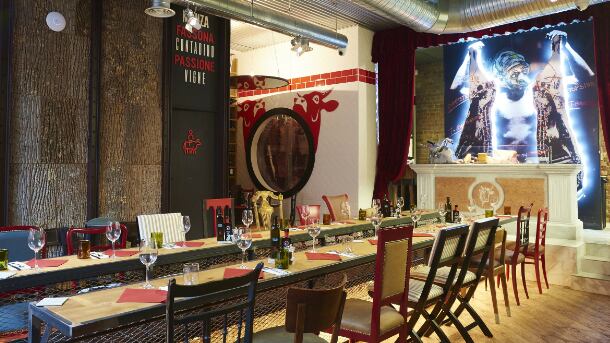
Setting the stage: Macellaio's Southwark site
Less cholesterol
The pair are both on a diet. Asif on the instruction of his wife, and Costa in preparation for the imminent birth of his second child. The latter has also given up cigarettes and espresso. “I’m barely an Italian anymore,” he laments. This new regime means the duo are avoiding the beef Macellaio is famous for, despite its healthy eating credentials.
“Fassone has less cholesterol than any other beef breed, and less than chicken and salmon too,” says Costa. “My grandfather and most other butchers in our region used meat from young French animals, but in my twenties I researched the different types and found that Piedmont, which is north of Liguria, produces this amazing breed. Another important difference with Fassone beef is that the animals live much longer; they’re normally slaughtered between four and five years old.”
“We also age our beef for much longer than most steak restaurants,” says Asif.
“Usually six to nine weeks. From a commercial point of view this is awkward. You generally don’t want to sit on a lot of stock, and meat loses weight as it ages. But it’s worth it because the quality of the meat ensures people come back.”
Fassone cattle are huge and comically muscly, the result of a mutation that provides a higher lean-to-fat ratio, as well as less marbling and less connective tissue. Because the meat is lean, the cooking process used at Macellaio is totally different to most steak restaurants, which usually favour aggressive searing on a very hot grill or in a Josper-style oven that combines direct and indirect cooking.
The meat is not pre-seasoned and is cooked in a combi-oven that allows the chef to set a precise temperature (300°C) and also control the humidity (10%). It’s an unusual approach, but it works.
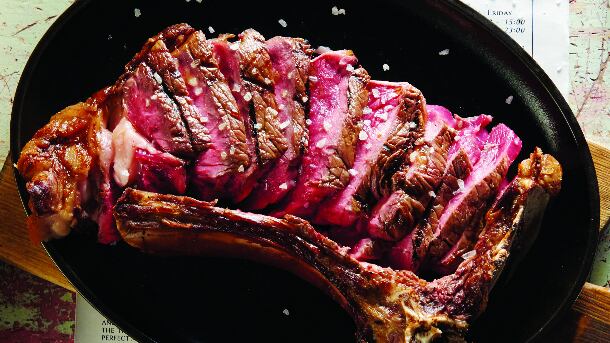
Macellaio's beef arrives once a week
Served simply with rock salt and peppery Tuscan extra virgin olive oil, the meat is spectacular; not entirely dissimilar to Spanish old cow beef, but cleaner and more delicate.
The pricing is competitive, with bone-in cuts priced between £6.20 and £6.40 per 100g and fillet at £9.50 per 100g. While it’s hardly dining on a budget, Macellaio offers its meat at a lower price point than fellow London premium steak specialists Hawksmoor and Goodman.
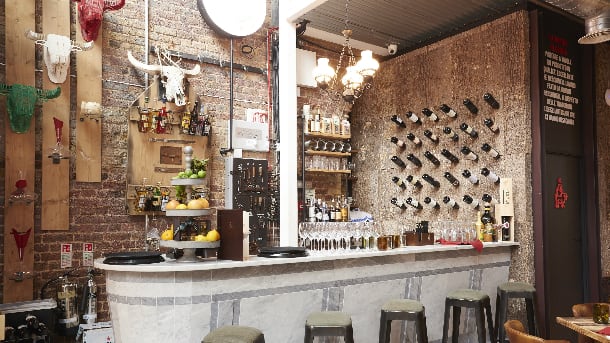
Counter service: The bar has Italian drinks to match the food
Supplier closeness
The comparatively low price is attributed to Costa’s closeness with his longstanding Piedmontese supplier and the fact that there isn’t much of a market for Fassone outside of Italy.
“Nobody knows it. You rarely see it on menus outside Italy,” says Costa. “The likes of Aberdeen Angus are expensive because everybody wants it. I was the first in London to use Fassone when we opened five years ago and only a handful of other restaurants serve it now.”
The beef arrives by van once a week. Despite Macellaio’s focus on butchery, getting animals in whole or as primal cuts would generate far too much non-prime meat, so Costa orders in only the rump, the sirloin and the loin.
Offcuts and less expensive parts are used in a number of more affordable preparations including carpaccio, tagliate and battuta, an Italian steak tartare made simply with olive oil, salt and a little pepper.
Macellaio’s menu does not read like one in a typical UK Italian restaurant. It stubbornly refuses to tick off obvious categories and dishes and eschews the antipasti, primi, secondi, dessert structure favoured by most upmarket Italians.
Printed on FT-pink newspaper, the menus at all three restaurants list the Fassone beef, a few pasta dishes, charcuterie and cheese, and a selection of ‘cucina povera’ dishes that includes ossobuco, tuna cacciatora and coda all vaccinara, the famous oxtail dish from Rome. The menus aren’t total facsimiles of each other, however.
The group’s second site in Clerkenwell’s Exmouth Market serves Sicilian bluefin tuna ‒ which is not as incongruous as it might sound ‒ with tuna butchered, aged and served in a comparable manner to beef. Tuna hangs in the window alongside the beef and is butchered to order.
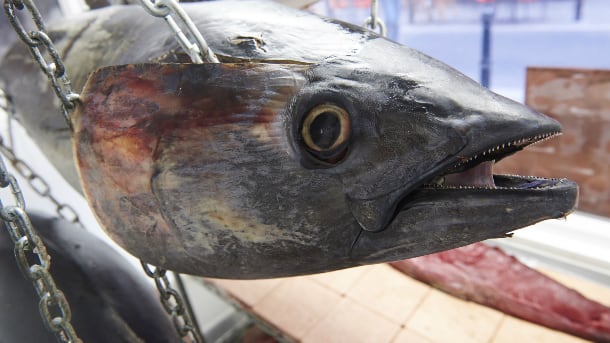
Shore thing: Tuna is the star of the show at the group's second site in Clerkenwell
Meanwhile the group’s most recently opened site in Southwark has a Ligurian bakery, offering the pizza-like pissa, filled savoury tarts and focaccia al formaggio tipo recco, a thin and crispy focaccia stuffed with stracchino cheese and topped with prosciutto crudo.
“Good Italian cooking is choosing just a few very good ingredients and cooking them well. I consider myself an ambassador for the ingredients, not the recipes,” says Costa.
“It’s a clever business model because you don’t need expensive chefs in every kitchen,” interjects Asif. “Roberto has identified a way of cooking that uses the true products but in a much less labour intensive way than other good Italian restaurants.”
“Macellaio is a restaurant that explores age,” says Costa. “You can see and taste that in the meat, the tuna, the cheese, the sourdough and of course the wine. The maturation is the most important thing. I learned this when I was very little watching my grandmother make ragu. It took seven or eight hours until it was perfect. Good food takes time.”
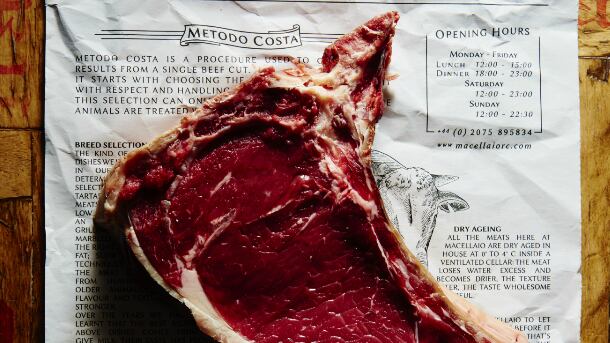
Lean times: Fassone beef has a higher than usual lean-to-fat ratio
Creative freedom
Costa and Asif split from the Italian parent company shortly after the opening of the Kensington restaurant.
“We wanted to change a number of things and this proved difficult,” says Asif. “Roberto gave up his stake in the parent company and after the first year of us leaving the group our revenue was up 22% year-on-year. I put that down to Roberto having total creative freedom.”
One senses that the pair’s Southwark site – tucked away under the railway arches across the road from Gordon Ramsay’s Union Street Café – hasn’t been entirely plain sailing. Brexit has also had a marked impact on the business. “It’s a big challenge. 18 months ago £1 was worth €1.40, now we’re more like €1.10,” says Asif. “We pay for a lot of products in euros so we’re feeling it. It’s a case of passing some of that on to the supplier, some to the customer and of course absorbing some of it ourselves.”
The pair’s expansion targets for Macellaio are modest – just one London restaurant a year for the next few years funded entirely by organic growth.
“We don’t want to be a chain,” says Costa. “Besides, if we got much bigger our beef supplier would struggle to keep up. We’re getting through about 1,000kg a week as it is. Each restaurant will have a different speciality. For our next Macellaio we’ll probably explore charcuterie.”

This year won’t see the opening of another Macellaio in London because the duo are close to securing a site in Milan.
“All the restaurants I had in Italy have closed since I exited the business. I’d love to bring what we do in London back home. We also want to open in New York because there’s a great steakhouse culture and a strong interest in Italian food yet there’s nowhere you can get Fassone beef,” says Costa.
There is another brand in the works, however. The pair are hoping to open a more casual restaurant format this year that will mine suburban London.
“It’s going to be called Osteria Number 8,” says Costa. “It will be very affordable at around £20 per head and we’ll serve simple, home-style dishes that aren’t often seen here. It will be food from Italy’s villages and towns rather than the big cities. We’re already looking at sites in locations such as Camberwell, Peckham and East Dulwich.”
Macellaio is a steakhouse that doesn’t serve a lot of the things people expect a steakhouse to serve – not least chips – and an Italian restaurant that only serves a handful of mainstream Italian dishes.
Its success is due to the quality of its products and Costa’s infectious enthusiasm, a trait he has managed to pass onto his nearly exclusively Italian front-of-house teams.
“We have to inform our guests,” he says. “The staff need to know about everything we serve. Behind every amazing product is an amazing person.”
This article first appeared in the April 2017 issue of Restaurant magazine, and was adapted for the web by Hannah Thompson. Subscribe to Restaurant magazine here from just £70 per year!
